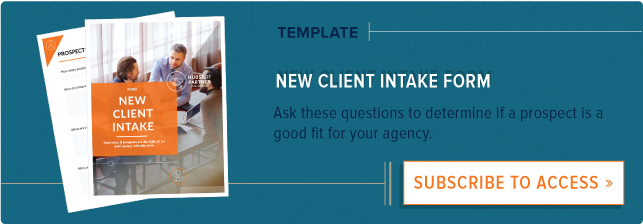Most agencies focus on the beginning -- the courting of a new client, the competition of the pitch, and the celebration of a win.

But the ending, which is inevitable, is just as important as the beginning. How you breakup shows what type of agency you really are.
So how do you close out a relationship in the right way? How do you go from exclusive to "just friends"?
How to Breakup With a Client Like a Professional
There are a lot of reasons why agencies and their clients breakup, such as:
- They want to move the work in-house.
- They want to consolidate their marketing and advertising activities and have chosen another firm.
- They are unhappy with the results or working relationship with the agency.
- A new executive team or CMO wants to work with an agency she has a prior relationship with.
- They are cutting the marketing budget and no longer can afford your services.
- You've fired the client.
Whatever the reason, most breakups don’t occur so that the connection is severed cleanly. It’s more similar to ending a marriage or a relationship with a live-in girlfriend or boyfriend. You still have to see each other. You still have to deal with one another’s “stuff.”
And you can’t either make this ugly or amicable. I would choose the latter. This is business after all. The agency-client “courting then marriage then breakup” analogy only applies to a certain point.
You never know who on the client side might move on to another brand and remember your agency in a positive light -- or the client could even return to your agency after working with another firm.
Be the agency the client regrets breaking up with by following these steps:
1) Create a transition plan.
Depending on the reason for the break, create a transition plan that outlines the stages of moving the work from your firm to the client-side or another agency. Position this as a way to reduce the amount of interruptions in the client’s marketing plans, any of which could create hiccups that reduce the chances of the client meeting their goals. This could be a 30-, 60-, or 90-day plan based on when the relationship end date is set for.
Transitioning could include training in-house marketers on what your agency has been handling -- this is a great way to extend the relationship for a few months and continue to retain the source of revenue while your new business team diligently works to find a new account to replace the lost revenue.
You might also be in a position to train the new agency partner or to meet on several occasions to discuss transition of documents and projects to their team. It’s similar to quitting a job. The work doesn’t stop the day you give your notice.
Both your client and the incoming agency will notice your collaborative and helpful approach, and that’s the best way to leave a relationship.
2) Deliver a project/relationship highlights.
If the client is going on to presumably “greener” pastures, it’s a good idea to review the relationship and provide the client with a document outlining all the “wins” of your relationship. If you collected benchmark data when you first began the relationship, you can compare what the client’s brand and its online presence look like now in comparison to the early days of your relationship.
This document should include major campaigns and achievements, and it should report increased performance in key metrics, such as:
- Visitors: Did you grow the total monthly visits to the client’s website? How?
- Leads: Were you able to increase the total number of leads generated per month or increase the conversion rate of the site to generate more leads?
- Customer acquisition cost: Were you able to reduce the CAC?
- Customer lifetime value (LTV): Were you able to increase the total value of each client?
- Ratio of LTV to CAC: Were you able to increase the ROI of your client’s sales and marketing teams by increasing the value derived from each customer?
- Marketing originated customers and leads: What percentage of leads are generated by marketing on a monthly basis, and how have you increased this percentage?
- Marketing influenced customer: Were you able to increase the percentage of leads who interacted with an asset from your marketing team prior to becoming customers? How did your work improve the sales process?
- Customer feedback: Do you have customer feedback or quotes from customers and prospects that relate to the work you did for the client?
3) Collect assets for transfer.
Even if the relationship only lasted one year, you've gathered a ton of information and assets that are the client’s property.
Organize all creative files, stock photos purchased, strategy documents, contracts or SOW information, fonts, logos, monthly reports, etc. Include any account login information for web services used during the relationship. In addition, include any training documentation you created as part of the transition plan.
You could send this over with a letter from the agency’s CEO or owner, thanking the client for the opportunity to work together, highlighting any big moments during the relationship, and wishing the client luck in the future. It's these small things that will go a long way to preserve your favorable image.
4) Conduct a client survey.
When’s the best time to get so-true-it-hurts feedback? After the breakup. This is when people feel like they can be honest -- they can air their grievances and provide praise. This will help you to close the loop between how you perceive the services you provide to clients and the reality. If you do this on a regular basis, you can begin to compare the net promoter score (NPS) from when you begin and end the relationship. And by conducting regular client surveys that include a NPS metric, you can track client happiness and satisfaction over time and better understand when a client is at-risk of leaving your agency.
Consider asking a few of these questions in your exit survey:
- How would you rate the initial new business process?
- How would you rate your onboarding experience with our agency?
- How would you rate the knowledge and expertise of our staff?
- How would you rate the level of communications you had with your account manager?
- How would you rate the level of communications you had with other members of our agency?
- How would you rate your overall experience with our agency?
- How would you rate the quality of the work provided?
- How would you rate the training and knowledge transfer our agency provided?
- Did we meet your goals?
- Are there additional deliverables or training you wish our agency had provided?
- What communication could be improved upon?
- How useful were the project update meetings?
- Why did you want to work with our agency?
- How likely are you to recommend our agency to a colleague or contact?
5) Ask the client to do a case study.
Case studies are the most helpful type of content during the stage of identifying solutions and considering providers, according to Eccolo Media’s B2B Technology Content Survey Report. If the relationship led to positive results for the client and they are leaving on good terms, ask if they would be involved. You've already gathered the key metrics. Now you just need a few quotes that reveal the benefits of working with your agency. Ask questions such as:
- What was the main problem you struggled with?
- What was the determining factor for choosing our agency?
- What did you like about working with our team? What types of relationships did you form with our staff members?
- What was the main benefit you saw from working with our agency?
6) Conduct an agency post-mortem.
The post-mortem will be a point of reflection for the entire team on the agency-client relationship. Especially if this was an important relationship or long-lasting one, you will want to understand what went wrong, what could have been better, and what your team can learn from the experience. This type of reflection can help your staff learn from mistakes made, reinforce positive behaviors, and reconsider how things are currently being accomplished.
If most of your work is project-based, this type of meeting is especially important for creating better processes, more accurate estimating, and better service delivery in the future.
The first step in a post-mortem is to send a survey to the client team. You need to better understand how the people on the front lines felt about the project or the relationship. Ask questions such as:
- On a scale of 1-10, how well did the team work together?
- How would you rate the team on effective communication with the client?
- Did team members contribute equally on the project?
- Did team members lead their respective areas while also being collaborative?
Then, plan a meeting to review the results of the survey and the overall relationship. Everyone on the project team should be present, and it would be beneficial to have your new business person, agency owner, or another key executive present for at least the part of the meeting. This person can provide background for how the client was sourced. They will need to understand if this client matched up to the agency’s ideal client profile, and if not, what qualifying questions or other processes need to change to eliminate these types of prospects during the new business phase.
During the meeting, outline these three areas and key discussion points:
History of the Relationship
- How did the client come to work with the agency?
- What were the initial goals?
- What were the initial challenges?
- What was the initial project scope?
The Project
- What the final project within the scope of the original plan?
- What went wrong in the project? Both from the client-side and the agency-side.
- What went right? Both from the client-side and the agency-side.
- How did the team like working with the client?
- What X lessons can be learned from this project?
- Was the project delivered on-time?
- Was the project profitable to the agency?
The Impact of the Client Relationship
- Should we add anything to our prospect qualifying questions based on this relationship?
- Do we need to adjust our scoping and project estimating process?
- Do we need more training or education on these types of projects?
- Should we change our creative process, such as feedback and reviews or the kickoff call?
- What should we do differently next time?
The End Is a New Beginning
Losing a client isn't the worst thing.
Take it as an opportunity to find a new account or to review how your agency works. Learn from the experience so that the next "beginning" makes for a longer, more profitable relationship.






